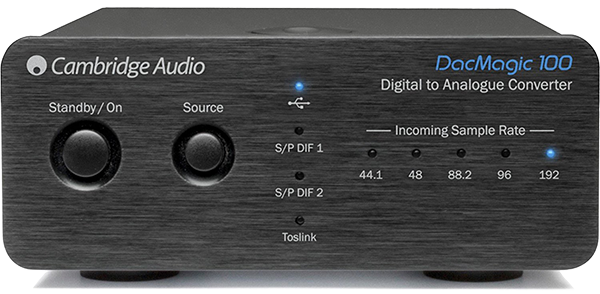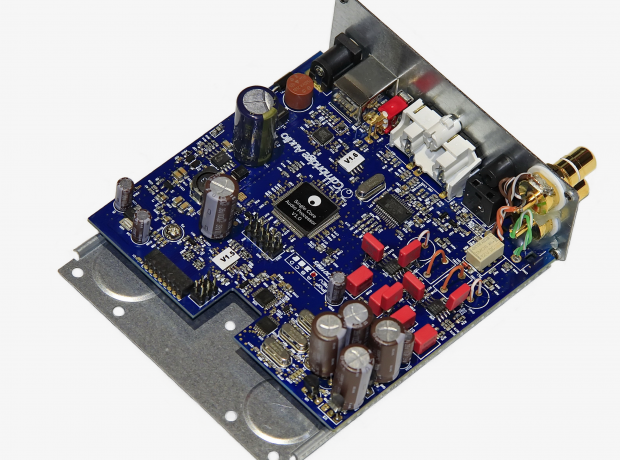Spis treści
DacMagic 100 is a popular device, having good opinion among the users. Its popularity is certainly influenced by the affordable price. Amount around 200USD is realy not much, considering the fact, that in this price we get device with nice and stylish look, signed with Cambridge Audio logo.
DacMagic 100 is a budget device in Cambridge Audio ofert. Its small dimensions means that it fits easily in hand. Device does’t have an integrated power supply, therefore the manufacturer includes an external impulse power supply to the factory set. Inside device is the digital to analog converter Wolfson WM8742, which cooperating with two NE5532 operational amplifiers. These are budget constructions, but they can be found even in much more expensive devices.
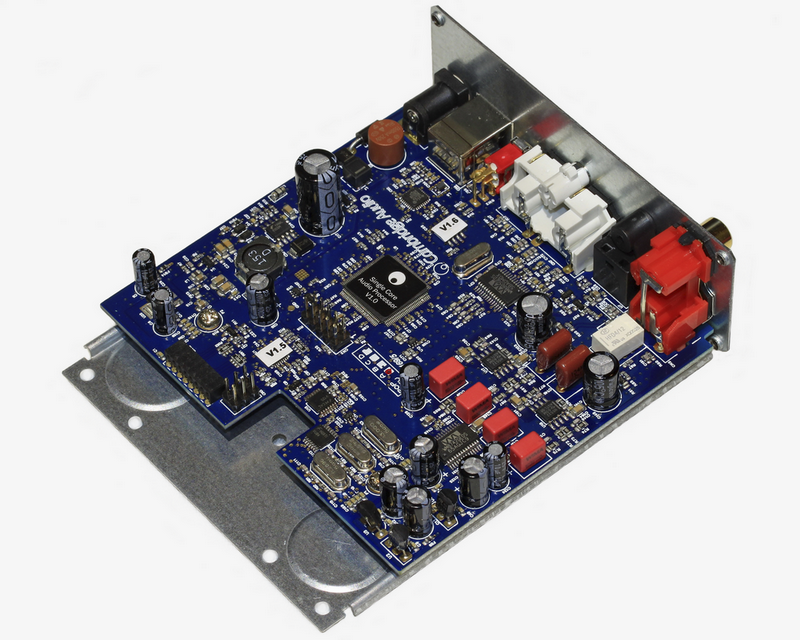
I opted for the Cambridge Audio DacMagic 100, because my intuition and experience told me, that this DAC has the potential, and with the right modifications can perform really well. Knowing what elements DacMagic 100 was built from, I did not expect a large qualitative jump in relation to my previous DAC E-MU 0204. DacMagic 100 has potential and its advantages, but I did not notice a change that would allow me to clearly state the superiority of DacMagic 100 over E-MU 0204. At this point, I must emphasize, that E-MU has some modifications consisting in the replacement of capacitors and output sockets.
Before I ultimately rated DacMagic 100, I let it work for some time. During the first dozen or so hours of work, the sound underwent considerable changes, but only after working for 100-200 hours I heard, that it finally stop changing and I could rate what changed in my system. My system is not hi end, but I appreciate it for its musicality and flexibility. Of course, this flexibility has its limits, but it is large enough to give even a little joy to listen to each of such extremely different genres of music as reggae or rock.
Unfortunately, DacMagic 100 has clearly limited this flexibility. The sound of DacMagic is correct and basically reflects the reviews that we find on the internet, it’s a really good D/A converter. However, it also has significant drawbacks. His biggest disadvantage is clearly imposed uniform character. All songs sound similarly and predictably, there is no question of any surprise or emotions. It reminds the kindergarten teacher, which makes sure that children are reciting a rhyme, in a way that does not allow for any deviations from the adopted template. Personally, this aspect is very bothering me and despite many advantages over the previous converter (E-MU), I feel quite unsatisfied, which makes me unable to forget my previous DAC. I lack musicality, freedom of sound and detachment from the speakers. The DacMagic 100 has a significantly higher dynamics and a very pleasant and fuller range of higher tones. The middle range protrudes little forward, but it is not insistent, only slightly emphasized. Unfortunately, all these advantages remain in the shadow of serious (as for me) flaws, which are lack of diversity and musicality.
DacMagic 100 unfortunately does not give such tangibility and contact with music. The boundary between the listener and the system is clearly delineated and takes away a lot of listening pleasure. The character of DacMagic can be described as rock, with a hard, compact and uniform bottom, underlined midrange and correct top, unfortunately, freedom is clearly lacking in all of this. DacMagic 100 has a lot of potential and possibility, I can hear it, I just need to help it spread his wings a bit.
Output capacitors replacement
In the output section of DacMagic 100, separating capacitors were used to protect the output from the appearance of a DC component. This is a classic pair of capacitors used in Cambridge Audio devices, electrolytic bipolar Fujicon and a 100nF foil capacitor that shunts it. With the Fujicon capacitors I already had contact during the modification of the AZUR 651A amplifier. These capacitors are of poor quality and have a significant negative impact on sound. They very limit the stage, close it in a small area, are grainy, unpleasantly sharpen the top of the range and play quite dark. The situation is saved a little by the foil capacitors which shunts them, they raise the middle and top range, but they also have their drawbacks. These are the elements that should be replaced as soon as possible, because the cost of replacement is small, and the change is noticed immediately.
Below I present a few combinations, which I decided to check to find the best solution for DacMagic 100. My proven solution is Nichicon ES + Mundorf Mcap. On the occasion of this modification, I decided to test different variants of Mundorf capacitor capacities. I also checked the option of leaving only a foil capacitor . This solution significantly reduces the capacity, but maybe so much capacity its not needded in this case?
On the internet I found a modification of the DacMagic 100, in which someone decided to replace the Fujicon capacitors with Nichicon Fine Gold capacitors, which has specified polarization. I have seen such solutions before and it does not seem to be the best idea, but by the way I decided to check it out
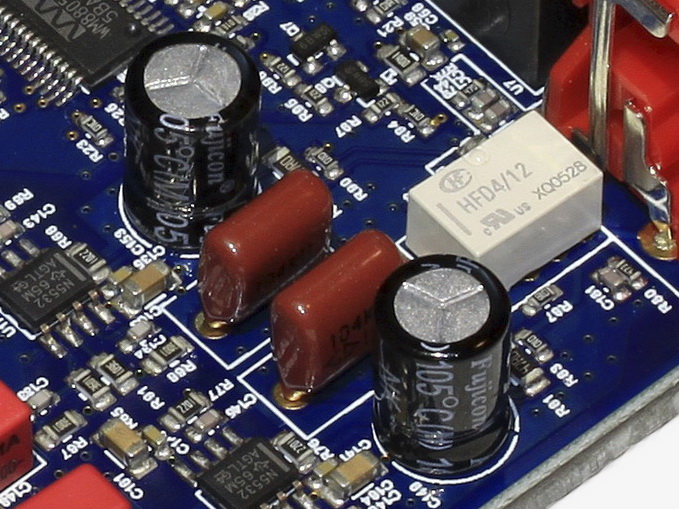

Nichicon Muse ES + factory set foil capacitor
The first variant I decided to check was a combination of Nichicon MUSE ES and a factory foil capacitor. Nichicon MUSE ES is capacitor I have already pleasure of testing and I consider it to be very good electrolytic capacitor for the audio path. In general, these are the only decent electrolytic capacitors for the audio path, which can be easily obtained at the moment. MUSE ES made a lot of changes. There was more space on the stage, mainly on the width. The depth has also increased, but only in the area between the speakers and the listener. The middle and upper frequencies have gained more life and freedom, the location of the virtual sources has clearly improved. Lower frequencies have gained in diversity and precision. They lost a bit on the mass, but in this case I consider it an advantage. Fujicon capacitor give more mass to the bottom, but at the same time make it sound the same for every genre of music. At first I got the impression that MUSE ES brightened the sound and gave it some unpleasant sharpness in the area of upper registers, but after a dozen hours of playing, the unpleasant sharpness clearly decreased.
Nichicon Muse ES
Out of curiosity, I decided to check how the MUSE ES will do without the factory set foil shunt capacitors. Electrolytic capacitors tend to sound worse than foil capacitors, which is why they are shunted with foil capacitors (such a solution also has its drawbacks). To my surprise, it turned out that MUSE ES are doing better without foil capacitors. The sharpness mentioned in the point above was significantly reduced, so responsible for it was the factory set foil capacitor. Nichicons still sound a bit sharply, but without the foil companions, this sharpness has fallen to an acceptable level. It got quite nice and peaceful. MUSE ES has made the energy served by DAC a new dimension. If someone likes the energy and the attack served by this DAC, he should try MUSE ES, these capacitors perfectly match the character of DacMagic 100.
This example showed me how important it is to choose the right components. As you can see the adopted rules are not always working and sometimes even less significant elements can have a big impact on the final result. Factory set foil capacitors formed a matched pair with dark Fujicons, but with MUSE ES the situation has clearly changed.
Nichicon Muse ES + Mundorf Mcap
For this variant I decided to check what changes will bring different capacity of Mundorf Mcap capacitors . To the test I chose values 0.15uF 630V, 2.2uF 250V, 6.8uF 250V. Mundorf Mcap is a very musical, slightly warming and giving a lot of air capacitor. Thanks to the combination of MUSE ES + Mundorf Mcap the scene has clearly expanded, especially in depth. The tonal balance improved, it got more neutral. Mcap clearly calmed down the sound served by the DAC. The music has finally begun to flow freely. Such a calm in the case of the DacMagic 100 could be considered a disadvantage, but thanks to it increased the diversity and the songs finally began to sound as they should. This is certainly a step in the right direction. DAC still has a lot of energy, but this energy began to be served with consideration and ceased to be forced.
Changes in the capacitance value of Mundorf Mcap capacitors were clearly heard and as the capacities increased, the sound stage and freedom of transmission grew and more details appeared. With factory set capacitors, I always felt as if the music was being given in constant stress and under close supervision, according to established rules. After applying the MUSE ES + Mundorf Mcap pair, all the unpleasant tension disappeared and the DAC gave the music a free hand and more freedom in expressing emotions.
Mundorf Mcap
It turned out, that the 100uF capacity is not needed to transfer the whole acoustic band. In principle, from a technical point of view, it was obvious from the beginning, but as we know, what “on paper” does not always reflect what we are actually able to hear. Mundorf Mcap clearly warmed the sound. This option will appeal to people who would like to calm down the DAC a bit. The sound lost some of its energy, but it gained more space and naturalness, which is especially evident for classical instruments. It’s possible that people who enjoy the energetic sound of the DacMagic 100 will feel some confusion, but after prolonged listening you can not get the impression that we received a lot of natural sound for price of this energy. Mundorf Mcap sounds similar to a jumper (described in the next chapter), which speaks for this option for people, who are looking for the most natural sound. Changing the capacity of the capacitor had a clear impact on the quality, which is why I recommend using the largest possible capacitor. During the tests, I was able to fit into DAC housing, capacitor 3.9uF 250V and this in pair with MUSE ES.
Jumper
As we know, each of the electrical elements introduces some distortion to the signal that passes through it. I decided to check what will happen when I apply the jumper in place of the output capacitor. The jumper practically costs nothing and can be considered as a reference element in this case. In order to obtain the best signal flow, I decided to use all four connection points and made two jumpers for each channel.
Probably no one will be surprised that the jumper sounds the best of all variants. The sound has gained practically in every aspect. The stage has grown in each of the three dimensions, but the most interesting changes have occurred on the width, where the music with incredible freedom began to go beyond the space between the speakers. The high tones have become fuller and gentler. The vocals in some songs gave the impression of listening to live music. Lower registers gained more warmth and depth, but compared to Mundorf Mcap, presented greater dynamics. In the case of a jumper, the DAC lost some of its energy, but it gained a lot of dynamic. As in the case of Mundorf Mcap, people who liked the DacMagic 100 energy may be a little mixed up with the result, but since “a piece of wire” introduced such changes, it can only mean that we received this energy at a considerable cost, which I personally can not accept.
The use of the jumpers is unfortunately associated with the risk of appearance a DC component on the DAC output in the event of a failure. It can be 8V (OPAMPs voltage) or even 12V. However, it should be remembered that the amplifier to which we connect the DAC may also have capacitors in the audio track that will stop DC component, which is why in some cases, it is worth considering the use of a jumper, because it will get the highest quality at the lowest cost. The use of the jumper can be considered as a step towards system optimization, if we are sure that the amplifier is able to stop the unwanted DC voltage and prevent it from reaching the speakers, then the use of capacitors at the DAC output is unnecessary.
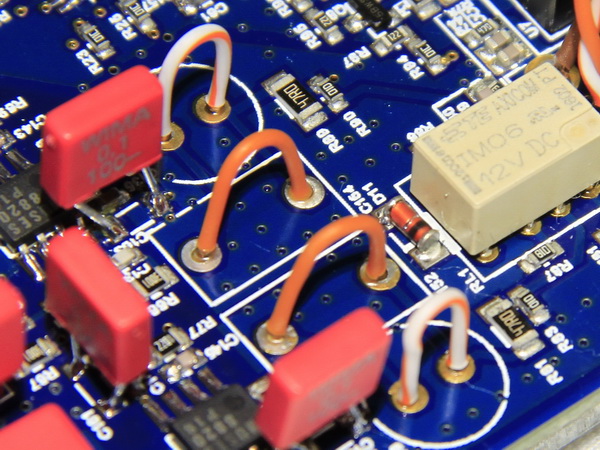
Jantzen Audio CrossCap 6.8uF 400V
To diversify the test, I decided to check what changes will be introduced by a decent foil capacitor at an affordable price, such as Jantzen Audio CrossCap, which I have in my collection. Jantzen Audio CrossCap sounds quite sharp and worse than Nichicon MUSE ES, which surprised me. I got the impression that it gave a bigger stage than MUSE ES, but the sharp top and hard bottom clearly masked its advantages, so that after a few songs I decided it was a missed option. I can say briefly that Jantzen Audio CrossCap does not go well with the DacMagic 100 and it’s better to use the cheaper Nichicon MUSE ES.
Nichicon FineGold vs Nichicon Muse ES
The issue of using capacitors with specified polarization in the audio path has already intrigued me for some time and I decided, that modifying the DAC is a good opportunity to check if such a solution makes sense. I met with this solution many times, so I decided to devote some time to check it.
It so happened that in my collection I have Nichicon FineGold 100uF 50V and Nichicon MUSE ES 100uF 25V capacitors. The comparison of MUSE ES and FineGold seems to me a good idea, because they are capacitors of the same class and the same company, so we can reject discrepancies resulting from technological differences. Both compared types of capacitors have identical dimensions and with these dimensions FineGold is able to withstand twice the voltage from MUSE ES, so there must be some physical differences in the construction of these capacitors, but can these differences be heard? Yes, it can be heard very clearly. In truth, the distortions introduced by a capacitor with a specific polarization are quite interesting. I am not surprised at all, that some people decide to use such capacitors, because the effect is interesting, it may even be desired under specific conditions, but it does not change the fact that it introduces large deformations also. Personally, I think such a compromise when modifying is unacceptable and senseless, because it significantly affects other changes.
Nichicon FineGold brightened the sound very much. The high registers have come out on first plan, the midrange was near behind them, and the lower registers remained far behind, although it gained in differentiation compared to Fujicon capacitors. In FineGold capacitor you can find a little bit of MUSE ES character, so the changes can be perceived as a step forward, but this is not MUSE ES. Bandwidth fragmentation is quite large and I do not think, that there is a dark enough system that would handle such a change, but there were people who liked it. Unfortunately, this is where the “advantages” of such a solution ends. Clear deformations in the whole band consisting of clipping the contours of sounds, make everything sound very unnatural. The hit the drum resembles a deaf hit in a plastic bucket, and the percussion plate makes only a short ticking, as if moment after the plate was hit, it stopped vibrate. The sound of the piano was the most fell into my memory, as if it has been stripped of its resonance box. The location of the virtual sources seems to be correct, but there is a lack of air around them, as if they were unnaturally hung in a vacuum, and the sound did not have a center on which it could move.
Thus, I personally advise against the use of capacitors with a specific polarization in the audio path, because it brings more losses than benefits. In principle, there are no benefits, only a situation can arise, where someone interprets the introduced deformations as a subjective advantage. Personally, I’d rather stay at factory Fujicones, than exchange them for capacitors with a specific polarization, no matter how high quality they would be.
Summary
Of all the tested variants, the best solutions in my opinion are:
- Jumper
- Mundorf Mcap 3.9uF 250V
- Mundorf Mcap 3.9uF 250V + Nichicon MUSE ES 100uF 25V
- Nichicon MUSE ES 100uF 25V
Jumper is the best and cheapest solution for a conscious user. I personally decided to leave the jumper, because I already have “protection” in the amplifier. Besides, after a few days of listening with a jumper, I decided that there was no return to capacitors.
In the case of other options, it is difficult to indicate the best solution, because the changes are significant and a lot may depend on individual preferences. Each variant introduces large and positive changes. Mundorf Mcap offers more warmth and naturalness. Nichicon MUSE ES however, allows you to continue to enjoy the high dynamics offered by the DacMagic 100, but unfortunately it adds some sharpens. The couple of MUSE ES costs about 1 USD, but the couple of Mundorf Mcap already cost 10 USD, so the price difference is big. As a basic option with a clear conscience I can recommend Nichicon MUSE ES, because the ratio of changes to the price made them undisputed favorites.
Power capacitors replacement
There are not many power capacitors in DacMagic 100 (there are a total 9 of them), so we can afford a bit of craziness and use capacitors from the top shelf. With this modification I decided to test the ELNA SILMIC II capacitors (on power input I used one Panasonic FC capacitor).
I was curious about the changes introduced by the ELNA SILMIC II capacitors, because I never used them before. Capacitors such as Panasonic FC/FM or Nichicon FG have their own unique character, so in some extent it can influence the sound of the device. Panasonic capacitors slightly warm up and calm down, the Nichicon FGs are more analytical and dynamic. ELNA SILMIC II surprised me with its neutrality. It give the impression that it do not affect the character of the sound in any way. Of course, it affect the improvement of quality. Clearly cleaned the stage, added air and precision. The range of higher frequencies has improved, gaining gentleness. The dynamics in the whole bandwidth also increased, but I did not hear underlining or coloring any of sound ranges.
I feel a bit unsatisfied, because I expected a clear effect, and nothing. SILMIC II capacitors are simply neutral. They do, what belongs to them, they clean up the mess in power and they do not even manifest their presence. They are very good capacitors and I can recommend them with a clear conscience. In total, they are an interesting alternative to the mentioned Nichicon FG and Panasonic FC/FM capacitors. It should, of course, be taken into account that a lot depends on the application itself and the use of ELNA SILMIC II in another device may bring different effects, but at this moment, in my opinion, they will remain neutral.
List of capacitors:
1x Panasonic FC 1000uF 35V
5x ELNA SILMIC II 100uF 35V
4x ELNA SILMIC II 10uF 35V


OP AMPs replacement
Probably no one will be surprised, that in DacMagic 100, Cambridge Audio used NE5532 opamps. It needs to be highlighted that that NE5532 is a very good opamp at its price, which is why it can be found in devices up to 10 times more expensive than DacMagic 100. Operational amplifiers are in the SO-8 enclosure, what making it a bit difficult to swap opamps, which is why I chose two favorites for testing, these are MUSES8820 and MUSES8920. Intuition told me that MUSES8820 should fit in well with the character of the DAC, but the sentiment made me the first to mount MUSES8920. Unfortunately, I was not happy with the changes introduced by MUSES8920. DAC calmed down too much, it changed completely from the factory configuration. DacMagic gained a lot of space and musicality, it opened up very much and the sound finally broke away from the loudspeakers, but it lost his energy and attack. I must admit that the MUSES8920 is more suited to calmer music, the songs sound just beautiful, you could immerse yourself in the chair and make dreamy. Unfortunately, with faster and more aggressive tracks, the DAC was terribly lost and late, you did not have to listen for a long time to know, that this is not its thing. It was the exact opposite of the factory configuration. MUSES8920 turned out to be a completely wrong idea for DacMagic 100, because despite some advantages, it forces to make too many compromises.
With MUSES8820 I had high hopes and I was not disappointed. This is the perfect opamp for this DAC. All advantages like dynamics, attack, fleshy bottom remained and at the same time gained a new dimension. Just like in the case of MUSES8920, the DAC opened up very much, the sound broke away from the speakers, and at last you could feel the contact with the music. The impression is really amazing. You can feel enormous energy and contact with every instrument. Scene and precision improved, the sources gained more space, they did not have to nestle, as was the case in the factory configuration. DAC finally began to play variously and reflect the atmosphere of a particular genre of music. However, during the first auditions, everything went to the background because the most interesting were the energy and dynamics introduced by MUSES8820. From long time I have not listened to a device that would give such a live transfer and so absorb the listener.
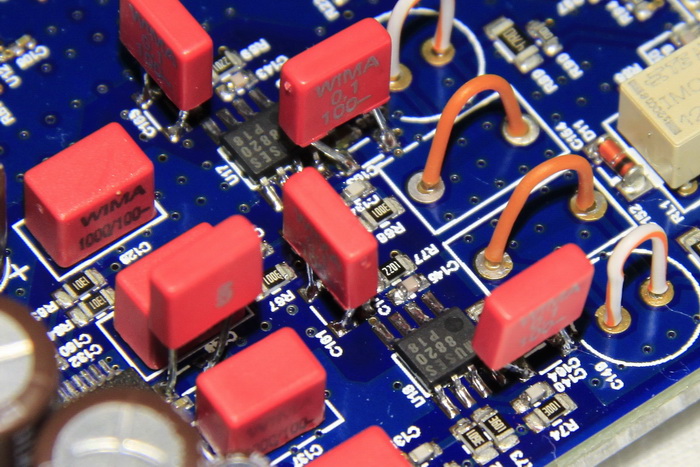
Output relay replacement
In the DacMagic 100, on the output was used the HONGFA company relay. Unfortunately, my knowledge about the quality of relays is small, so I based the information provided by the manufacturer, and from them it resulted, that the relay is of decent quality (gold-plated contacts).
To be sure, I decided to check whether the relay has no negative effect on the sound, bypassing it with a jumper. Of course, such shorting of the relay is associated with a some risk and you should proceed with caution. Relays are not cheap and nobody uses them for no reason, especially in budget constructions. Most often, their task is to activate the output of the device only when its state is established, to prevent any interferences (noises/glitches) from appearing on the output. Short circuit of the relay positively influenced the sound, the changes were audible at once, it was a clear step towards more analog sound. The sound became milder and fuller. The conclusion was simple, the relay has a negative effect on the sound. The impact of the relay was so clear that after removing the jumper I could not stop hearing it and with every subsequent song I was thinking how it would be without a relay.
I decided to check if I could buy a better quality relay, but unfortunately it was not easy to replace HONGFA relay. From my analysis, it transpired that the relay used, practically does not differ in parameters from relays of other companies, but I know from experience that not all changes can be seen on paper. The availability of micro relays it is not such an easy matter. In principle, in Poland and with a decent delivery time, I had only one relay to choose from. I decided to take the risk and purchase a TE Connectivity (AXICOM) relay model 2-1462037-7.
The purchased relay proved to be better than the one mounted at the factory. After initial listening, I decided to check if I heard any changes with a jumper that bypassed the relay. I must admit that I have not heard any differences. Maybe after a longer listening session something could be heard, but the first impression is the lack of any changes.
The most interesting is the fact that these relays do not differ in terms of parameters.

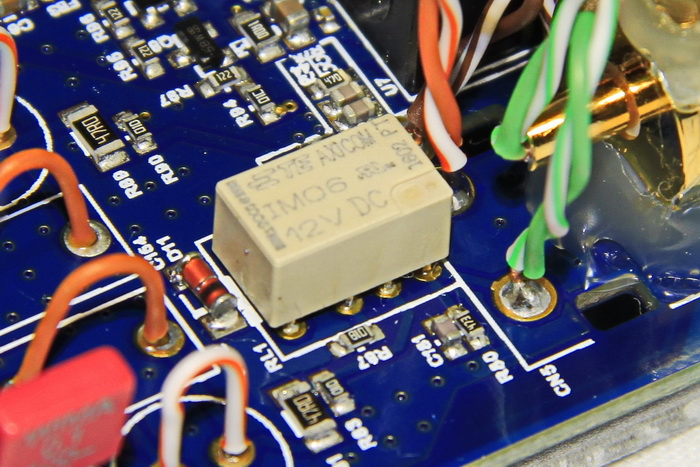
Decoupling capacitors replacement
The decoupling capacitors are designed to remove the variable component from the supply voltage, and so all undesired disturbances, that may affect the deterioration of sound quality. It must be admitted that Cambridge Audio has contributed to the task in this matter and decoupling capacitors can be found in many places on the device. In order not to intervene too long, I will limit myself to describing the places where I decided to make changes, namely at operational amplifiers and the digital-to-analog converter circuit. As we can see in the picture below, the manufacturer decided to use a pair of SMD capacitors (bigger and smaller) to improve the efficiency of filtering. The larger capacitor has a capacity of 10uF, while the smaller capacitance I did not check, because I would have to desolder it, and I was afraid that I would not sold it back again, due to the small dimensions. I decided to leave smaller capacitors and replace larger ones.
I decided to use WIMA MKS2 capacitors with a capacity of 100nF. I have used these capacitors in many applications before, as decoupling capacitors and they perform very well in this role. The difference in capacity between new and factory set capacitors is large, but in this case the capacity is of secondary importance. An important parameter is the ability of the capacitor to remove interference from the power supply, so that these do not enter the signal path, and this WIMA MKS2 does very well. Many people do not realize how big role the decoupling capacitors play and how much can be gained thanks to them, at a low cost. DacMagic 100 is not an exception in this matter. The biggest change is a enlargement of the stage and its aeration. This is next step towards a natural and full sound. With this change, the song “Pink Floyd – One of My Turns” was the most memorable for me, and exactly the walk of a woman at the beginning of the song. For the first time I heard clearly the whole passage from left to right, which is really a great achievement, because in this track, even on “good equipment”, you can hear the woman mostly in three points (left side, center, right side).
This example shows how much interference was still getting in into the integrated circuits, despite the use of two SMD capacitors to decouple the power supply. Of course, we will never be able to completely get rid of interference, however, obtaining such a clearly audible change at a low cost (1 USD for 5 capacitors) is worth attention.
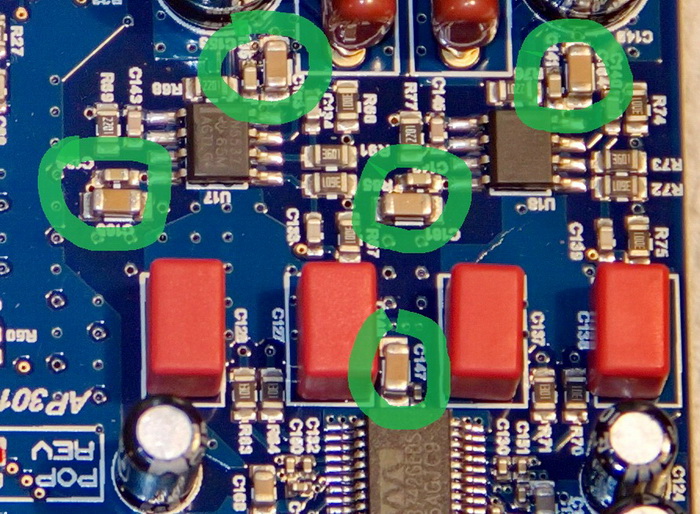

RCA sockets replacement
Replacing RCA sockets is a very interesting issue. I must admit, that the sockets used in the DacMagic 100 are of decent quality and this type of sockets also occurs in much more expensive constructions. Unfortunately, the factory set socket has a serious disadvantage, which is the very small contact surface of the signal line. The matter is quite strange and I do not fully understand it, because from a technical point of view, the contact surface with a negligible current should not be of much importance. It is possible that the surface in terms of load is not issue here, but rather the quality of the contact. However, this does not change the fact that replacing the factory set RCA sockets has brought audible changes. Interestingly, the sockets I exchanged only in the DAC side, while the sockets on the amplifier side were not replaced, and yet there is improvement. More than once I had the opportunity to see how much we can lose at joints, but I have never had the opportunity to hear changes for such a small modification.
The whole thing is a bit grotesque, because many of us have become accustomed to spending lots of money on wires with gold-plated plugs, and hardly anyone is aware that he puts these plugs in maybe the worst slots, but certainly ones, that do not allow to use fully the possibilities of golden plugs. A little bit of bitterness is added by the fact that to get a clear improvement in quality, you do not have to invest in gold-plated socket for dozens of dolars, a socket made of brass or copper for about 2 USD per piece is good enough. The sockets used by me cost 3.5 USD per piece, but I used them because I did not have cheaper sockets on hand. It is important to pay attention to how the signal pin connection is made. In the sockets that I use, the signal pin, it enters a brass or copper sleeve, which certainly provides a better connection quality than the “fork” shown in the picture below, which I took out from the factory set socket.
Since I already sowed another audio voodoo grain, it was left to describe what changes the new RCA sockets introduce. Briefly, it is a small step towards a more analogue sound. The quality of upper and middle registers has improved, they are milder and fuller. With this modification, the song “Jan Garbarek – Gula Gula” came to my mind the most. Before the modification, at the peak moments the saxophone sometimes gave the impression of losing control and unpleasantly irritated the ears. After changing the RCA sockets, this phenomenon has decreased and even at higher volumes, it no longer make me feel discomfort. The lower registers have also gained and become warmer. The change at the bottom is most audible for classical instruments such as double bass or piano. It’s really worth thinking about the issue of replacing the RCA sockets, especially when using wires for three digital (or more) sums. I think that 7 USD invested in this modification was a good step, although I could fit the price of 4-5 USD. When I compare the changes introduced by replacing the RCA sockets in the DAC with the changes that my current interconnect (WireWorld Solstice 7) introduced to my system, those 7 USD were a very good investment. In other words, the socket finally approached the plug in class.
This is not the first device in which I hear changes after replacing the RCA sockets, because in my previous DAC I also heard them, and there I exchanged RCA sockets for cheaper, at a price of 2 USD per piece. The pictures below show the new RCA sockets and the signal connector of the factory RCA socket.
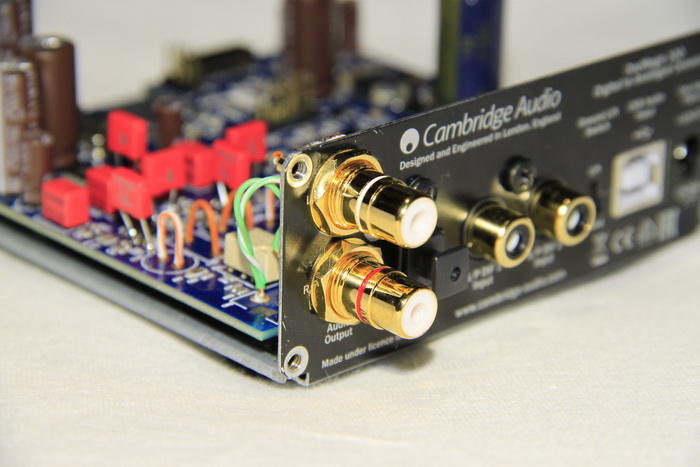
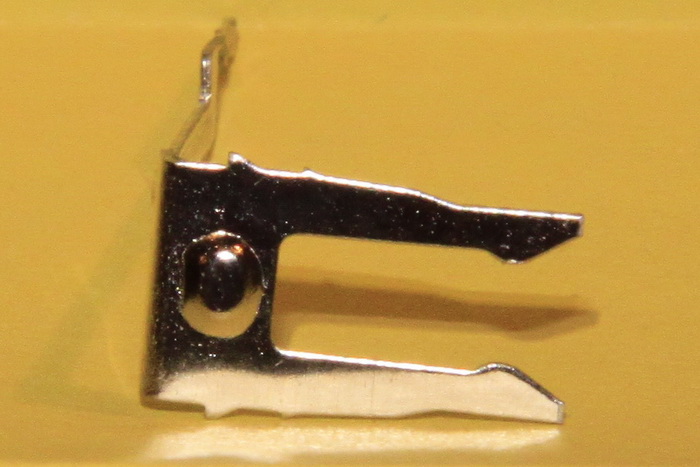
D/A converter replacement to WM8741
Replacing the D/A converter was not planned at first by me. According to the data provided in technical documentation, WM8741 differs from WM8742 only by the dynamic range, by a whole 2 dB, so I decided that replacing the converter does not make much sense, considering its not small price. Not from today I know that the quality and repeatability of the production of integrated components leaves much to be desired and once again I became convinced ,when one of my colleagues decided to modify his device and sent me his specimen of the DAC. Both before and after the introduction of all previous modifications, his DAC was sound different. My suspicion fell on WM8742 converter. This experience has caused, that I decided to check what changes will take place in my DAC after replacing the converter with a more expensive version of WM8741.
The converter replacement confirmed my suspicions, that the discrepancy I heard between the two DACs was due to differences in the construction of the D/A converters WM8742. As for the differences between the WM8741 and WM8742 chips, they are really big and the WM8741 chip replacement was a very good idea. The most I wonder is whether these converters differ in something physically, or are simply classified for hearing, because according to the documentation they are practically identical, and the differences given in the parameters are probably only for the principle.
Certainly, the differences in parameters do not reflect what I hear after replacing the converter with WM8741. The dynamics and coherence increased significantly, the control of the lower registers improved, as if the DF (damping factor) of amplifier suddenly increased 2-3 times, or my 8 inch woofer started thinking, that it is only a 6 inch. There is clearly more lower registers now, but thanks to good control they does not impose. The midrange and the top gained more precision, which added more depth to the stage and better separation of sources. I recommend replacing the converter with WM8741, because it is really worth it.
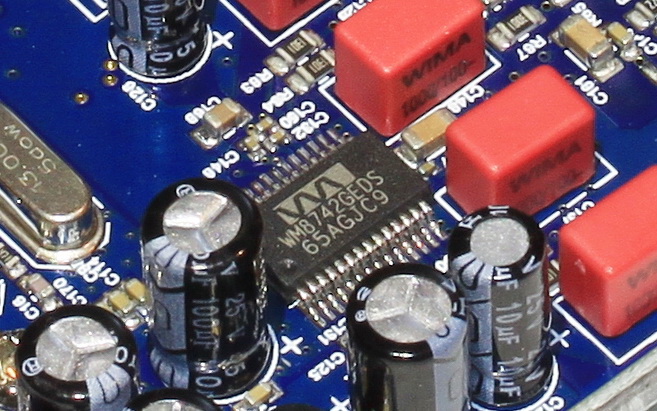
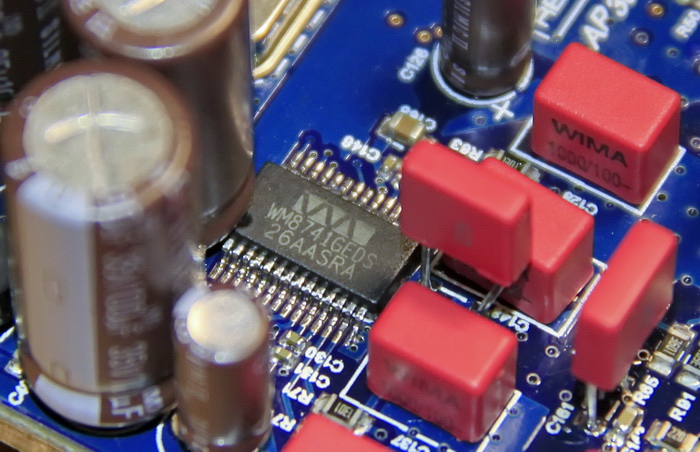
The use of a stabilized power supply
In factory set the DacMagic 100 has been equipped with a small impulse power supply. Impulse power supplies due to the generation of a large number of disturbances, are not the best solution for powering audio devices, however, their undeniable advantage is the small price and dimensions. I never used an external stabilized power supply and I was very curious to know what changes will be made and what their relation to the costs will be. Because I have two DACs and I like challenges, I decided to design and assemble my own power supply. I estimated that in the price which I would have to pay for a ready power supply, I should build two power supplys with similar parameters myself and the plan was successful. Creating my own design turned out to be not so simple and made me realize that the commonly accepted principles when creating stabilized power supplies, are not really useful when it comes to powering audio devices. Specialists from creating power supplies would probably point out a few design mistakes and thought that the power supply is overvalued, but my basic assumption was to create a 12V 3A device, which DacMagic 100 will not use, but my second DAC ASUS Xonar STU DAC already yes, that’s why I created two twin constructions.
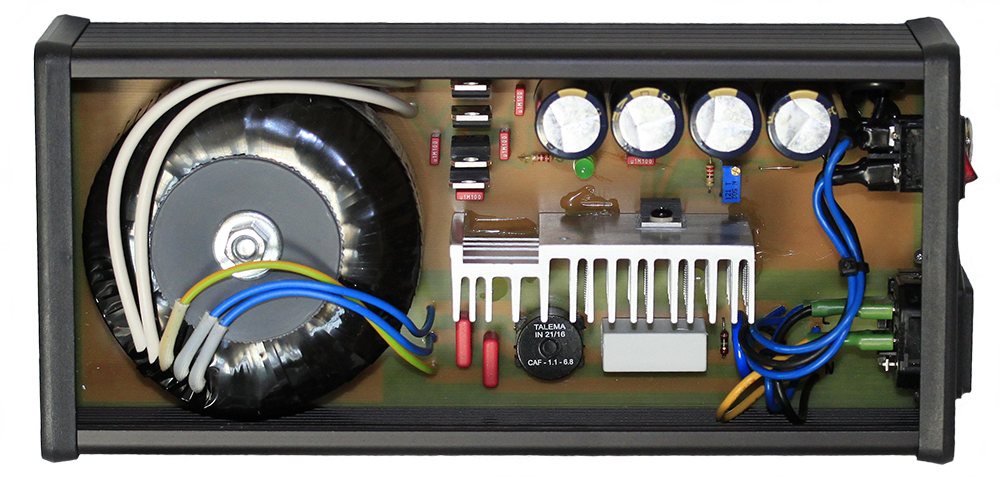
To tell the truth, to describe fully and reliably the process of creating and testing this power supply, I would have to create a separate article. Therefore, to avoid writing too much, I will focus only on the most important aspects and impressions after connecting the finished power supply to the DAC. The power supply is based on the LM350 voltage regulator. It is a popular regulator containing short-circuit and thermal protection. LM350 is a very simple and easy to implement solution. According to the art, the output of the voltage regulator should be connected directly to the output of the power supply. You can place a small capacitor on the output, but it should not be too big, because too large capacity can cause so-called ripple, in other words voltage spikes caused by changes in the load value. Of course, in accordance with art, I used a capacitor with a capacity of 10uF. I noticed that many constructions, even recognized producers, based on LM350 regulators, are created in such a way, so I decided to stick to the rules. The power supply has passed short-circuit and load tests and I also checked if it not generates interference. Everything looked promising.
The first impression after connecting the new power supply was a little consternation. Based on the relationships of other people, I expected a significant jump in quality, but I experienced a small disappointment. My first conclusion was that the replacement from impulse power supply to stabilized power supply, is not such a clear and unambiguous jump into a better world. Due to the fact that the power supply cost me not a little, because about 80 USD I was counting on the indisputable and uncompromising qualitative jump. Unfortunately, this didn’t happen, and the compromise introduced by the new power supply caused, that at the beginning I even considered returning to the impulse power supply. In fact, the first impression is the best indicator of changes, because once you hear a clear improvement, it is a clear sign that you are going in the right direction.
Connecting the new power supply made the sound more analytical, the stage gained a lot of space (mainly in depth) and a clearer height dimension appeared. The apparent sources gained even more space and finally I could feel the atmosphere and the “room dimensions”. I can hear the increase in control and discipline, the recording must be really bad, to get something breaks out ahead of the row or unpleasantly irritated the ears. The advantages of the new power supply is really a lot, but … well, there is some but.
With a impulse power supply, the DAC plays with incredible energy and momentum. The effect is very interesting and engaging, but connecting a stabilized power supply made me aware that along with energy and vigor, the impulse power supply introduced a lot of chaos, noise and lack of control, which was most reflected on the stage. The new power supply made the DAC retreat a little. He did not close himself as before replacing opamps, but the first auditions showed that something was wrong. The biggest unwanted changes happened at the lower registers. Looking from the technical side, the lower registers improved the same as the rest of the band, but it lost its energy and differentiation, it has stopped enjoying and surprising so much. I noticed in a few classic songs, that on this change suffered for example, a double bass, it ceased to sound with such ease, as if someone has put into its resonance box a damping material. I went back several times to the impulse power supply, because I missed some of the energy, whitch the new power supply took away, but the longer I listened to the new power supply, the more I liked the changes it introduced and I knew that this is a good direction. However, the compromise I had to make was hard to accept.
The power supply was working like this for several days. At that time, I tried to convince myself, that it should be so and I have to get used to changes. Fortunately, I’m too stubborn and inquisitive to leave this point this way. I decided to verify if the power supply is working properly. I thought to compare power supply to the battery. I had a 12.3V car battery at hand. I connected the battery and finally heard what I had hoped for. There was openness and energy that was so lacking. This is how the new power supply should work. I started to wonder if the LM350 regulator really is so fast in terms of voltage stabilization? The DAC is a specific device and its load changes are small, and if they occur they are certainly fast, maybe too fast for the LM350? I decided to run the experiment and added a 1000uF capacitor at the LM350 output. This solution turned out to be a bull’s-eye. The power supply started to play clearly better. Then I added two more capacitors, which in total gave 3000uF at the output of the power supply. The effect is very positive, the power supply “started to play” just like with the battery.
This example shows that sometimes it is worth moving away from conventional thinking. Of course adding such a large capacity at the output of the LM350 regulator would be a mistake, if I was designing a universal power supply, to power everything, because it certainly has a negative effect on the ability to respond to load changes by the LM350. However, in this case, it is not a universal power supply, but designed for a specific type of device, that responds very positively to such unconventional solutions. Substantially the DAC itself has one 1000uF capacitor on its input (Panasonic FC), and 3000uF on the output of the power supply is only an enlargement of this capacity, because both capacities are connected by a wire/path, and are only found in other housings.
In conclusion, I am very happy with the results. The stabilized power supply, despite the introduction of large positive changes, I consider the least profitable modification due to the high price, although 35% of the price is the cost of the enclosure itself, so the power supply could be even cheaper, but the cost will still be high. I must admit, however, that this is a change from which I would not be able to give up. In addition, the power supply is an investment for the future, because we can use it with multiple devices.
Summary
After reading the advantages that each modification introduced, one would get the impression that after adding them, I obtained a reference device. Unfortunately, it is not so good, but the DAC has changed a lot. When I bought this device, I was a little disappointed, because after good opinions from other people I was expecting something more at the price of almost 200 USD. After modifications, I can write that DacMagic 100 could rub the nose of many devices at a price of 300-400 USD and at this level I judge, what currently presents this DAC. Though I would not be surprised at all, as if in the mainstream of prices its value reached even higher. With this calculation, I do not include changes made by the power supply, because the power supply is not an investment in the device itself, but rather in the whole system, because once purchased it can supply other DACs to.
List of elements:
- 2x OPAMP MUSES8820
- 1x relay AXICOM model 2-1462037-7
- 2x RCA sockets
- 4x ELNA SILMIC II RFS 10uF/35V
- 5x ELNA SILMIC II RFS 100uF/35V
- 1x Panasonic FC 1000uF/35V
- 5x WIMA MKS2 100nF/100V 5%
- 1x D/A converter WM8741
- 2x output capacitor (Nichicon ES, Mundorf Mcap) or jumper
The price of all the elements is really small, considering how much I managed to get out of this small device. This modification once again showed me that it is worth taking a look inside the device and not treating it like a black box.
The DAC has maintained its character and tendency to brighten and emphasize the midrange, but this trend has clearly decreased and you have to listen to a few songs before you hear it. DAC has ceased to impose its conditions, and only subtly underlines the higher ranges. This makes the DacMagic 100 start playing more universally and naturally. The factory set DacMagic 100 was slightly worse than my previous modified DAC E-MU 0204, after the modifications it is clearly better. In addition to openness, which I missed so much, I got a clear increase in the dynamics, the size of the stage and the quality of the upper registers.
Below are pictures of DacMagic 100 before and after modification.



